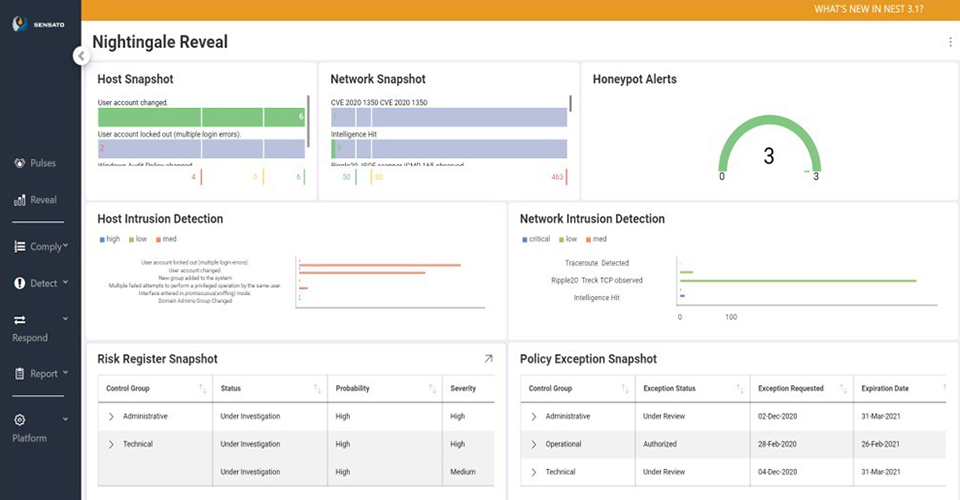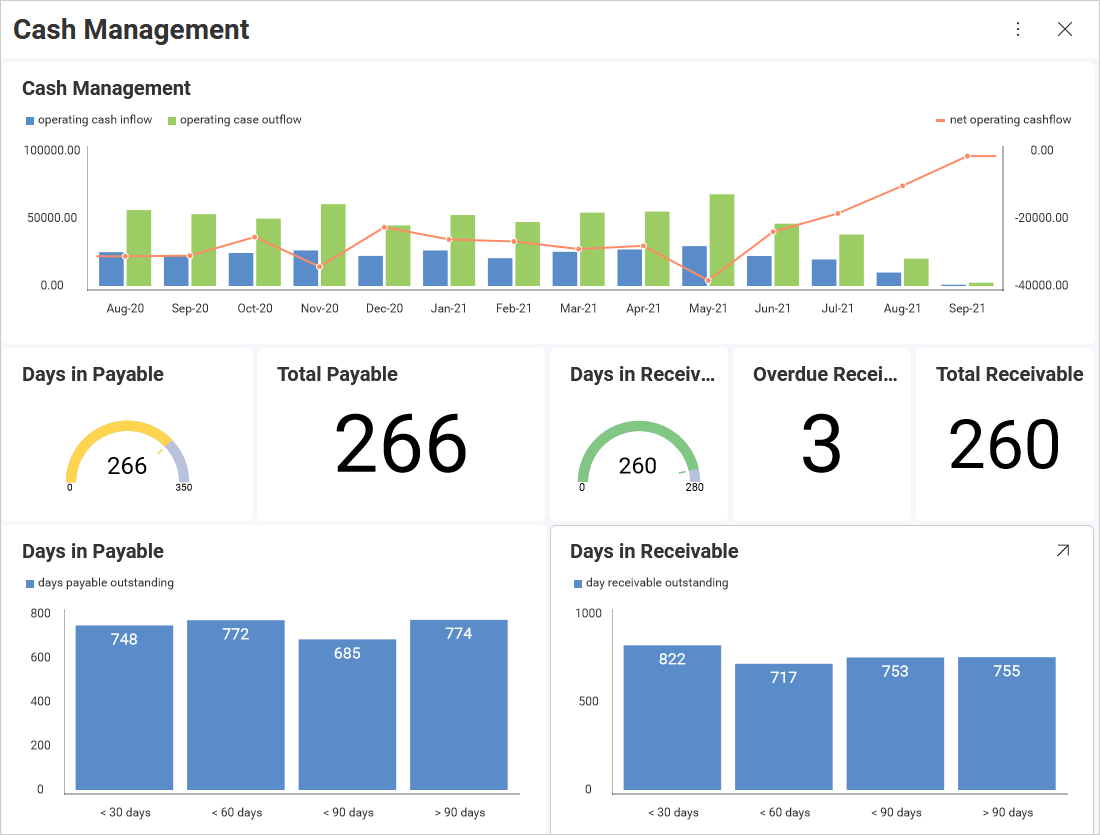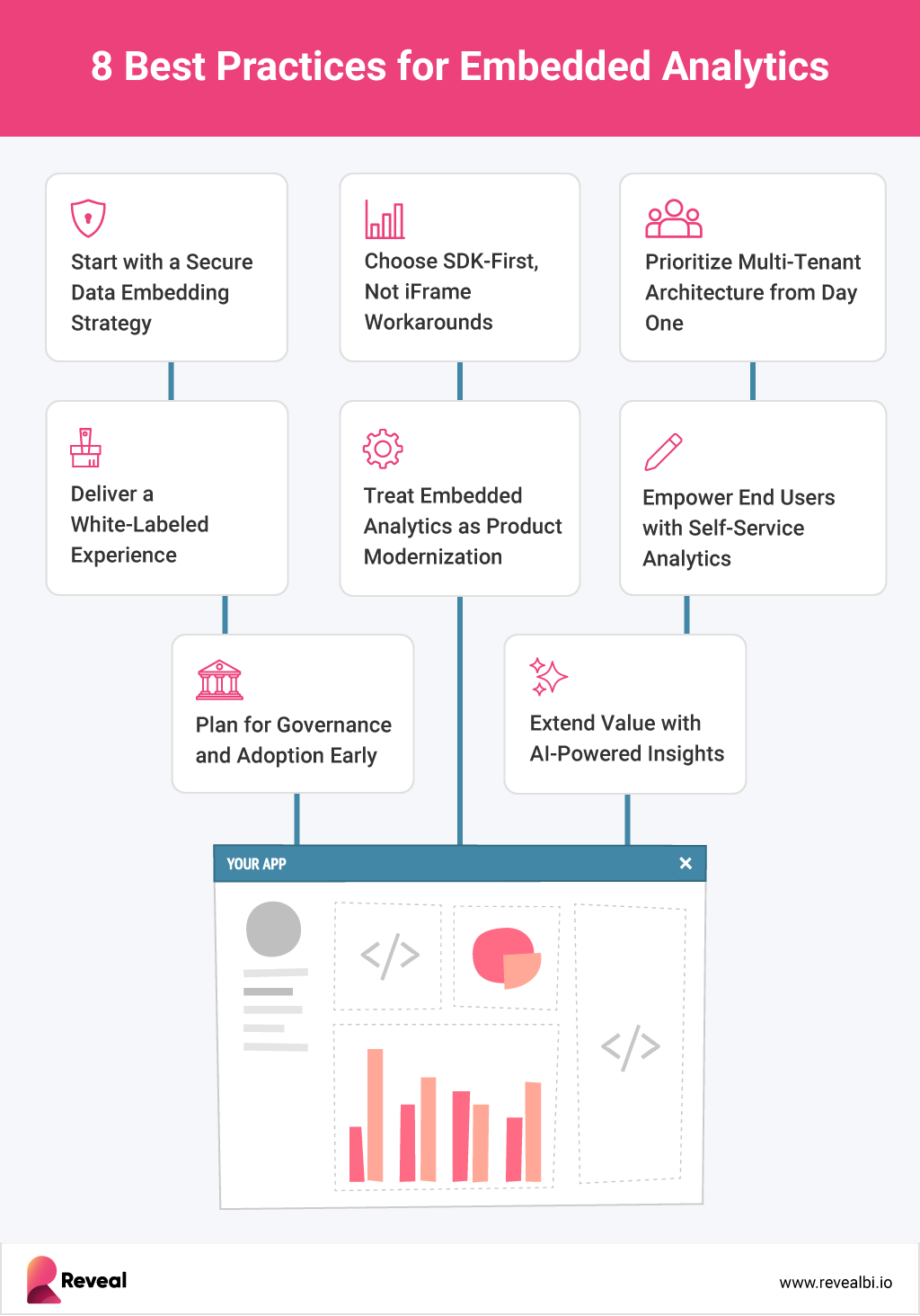
8 Steps to Embedded Analytics in FinTech Success
FinTech products compete on trust, compliance, and speed. Customers expect insights inside the product, not in external BI portals. That’s where embedded analytics in FinTech becomes critical. By embedding secure, branded dashboards directly into applications, SaaS teams meet regulatory demands, scale across tenants, and build adoption without slowing product roadmaps.
Executive Summary:
Key Takeaways:
- Embedded analytics delivers real-time, branded insights that strengthen trust.
- Embedded analytics delivers real-time, branded insights that strengthen trust.
- Multi-tenant scalability and role-based governance are must-haves for financial platforms.
- Sensato proves secure, embedded dashboards work in regulated industries.
- Reveal enables white-label analytics that reduce dev backlog and unlock new revenue.
FinTech products must win on trust, speed, and compliance. Yet many still struggle to deliver the insights customers expect. Customers expect secure, real-time visibility into their data. Yet too often, dashboards sit in external portals, reports take days, and compliance risk grows with every integration. These gaps limit growth, making embedded analytics in FinTech essential for product leaders.
Instead of bolting on external BI, embedded analytics builds dashboards and reporting into your core application. That means real-time dashboards and contextual insights delivered where decisions happen. It also means stronger data security and governance, since you control how analytics interact with customer workflows. According to Reveal’s 2024 survey, 81% of analytics users rely on embedded analytics in 2025, showing that integrated insights are now the market standard.
The pressure is real. In 2025, 51% of tech leaders identified security as their top development challenge, while 41% pointed to data privacy. For financial applications, these aren’t optional concerns. Investing in secure, embedded analytics for finance enables regulatory compliance, rapid scaling, and higher user satisfaction.
Why FinTech Needs Embedded Analytics More Than Ever
Financial platforms face relentless pressure to deliver insights that are fast, compliant, and scalable. Customers expect secure dashboards that feel like part of the product, not an afterthought. This is why embedded analytics in FinTech has shifted from a differentiator to a requirement for growth.
Legacy systems hold many teams back. In a recent survey, 32% of users identified legacy infrastructure as the top barrier to adopting embedded analytics. For FinTech, this risk is even higher. Outdated BI tools cannot keep pace with regulatory requirements, client data isolation, or the demand for role-based access across multi-tenant platforms. Without an embedded approach, financial software struggles to scale securely.
The opportunity is equally clear. Embedded analytics is set to reach $55.54 billion by 2030, and the platforms that win will be those offering real-time, compliant insights natively. That means delivering FinTech analytics dashboards that are branded, governed, and designed for scalability from day one.

We see this in regulated industries already. Sensato, a cybersecurity provider, needed to give clients compliant, real-time visibility without exposing sensitive data. They chose a solution built for secure, white-label analytics, proving that teams operating in high-stakes environments can embed dashboards seamlessly while maintaining strict governance. For FinTech SaaS companies and ISVs, the same principle applies: building trust depends on analytics that scale without slowing innovation.
In short, embedded analytics in FinTech enables financial software leaders to deliver secure insights, preserve UX consistency, and outpace competitors in a fast-growing market.
Why Traditional BI Fails FinTech Applications
Traditional BI tools were never designed for customer-facing software. They require users to leave the application, log into separate portals, and adapt to interfaces that feel disconnected from the product. For FinTech customers who expect immediate, in-context visibility, this disconnect reduces trust and slows decision-making.
These tools also lack the governance and flexibility financial platforms need. They struggle to deliver strict data security and governance, row-level permissions, and compliance dashboards across multi-tenant environments. For SaaS teams, this means workarounds, manual reporting, and high maintenance costs.
Attempts to embed these tools often rely on iFrames or shallow integrations. The result is a solution that looks external and weakens adoption. As enterprise BI continues to dominate internal analytics, it falls short when applied to FinTech products that demand seamless, secure, and branded experiences.
This is where the shift toward embedded analytics in FinTech becomes clear. Financial software requires analytics that scale with the product, not tools that force customers out of it.
Embedded Analytics in FinTech as the Solution

Traditional BI leaves gaps, but CTOs need forward-looking answers, not more problems. This is where embedded analytics in FinTech becomes the smarter path forward. By building secure, scalable, and branded dashboards into the product itself, teams move faster while staying compliant.
Security, governance, and compliance by design
Financial platforms cannot compromise on governance. Embedded analytics integrates directly with your access model, so you control role-based access, authentication, and permissions. Sensitive data never leaves approved pipelines. You can extend self-service analytics to users without sacrificing compliance, enabling faster answers with full audit visibility.
Scale across tenants and diverse data sources
FinTech platforms depend on distributed architectures. A modern SDK supports multi-tenant architecture with strict data isolation. As you add customers, performance remains steady. You can connect trusted data sources and deploy FinTech analytics dashboards with low latency, even under heavy workloads. That’s scalability for SaaS delivered in practice.
Deliver a fully branded, native experience
Analytics should feel invisible—an extension of the core product. With white label analytics software, you can apply full branding, UX, and layout control. From fonts and colors to logic and permissions, dashboards reflect your product’s identity. Teams deliver financial dashboard software that feels owned, not bolted on, driving higher adoption and customer trust.
Ship faster, reduce backlog, empower teams
Embedding analytics through SDKs reduces reliance on long BI cycles. Developers configure once and reuse across features. Analysts create governed content that ships without dev bottlenecks. This model keeps your engineers focused on core roadmap priorities.
- Centralize permissions and sharing
- Reuse dashboards across tenants
- Localize currencies and languages with configuration
- Track usage to inform roadmap
Extend insights with AI
Fraud detection, risk scoring, and anomaly tracking require more than static dashboards. Built-in AI-powered analytics delivers guided analysis and predictive models. Teams surface anomalies earlier and explain trends without leaving the product. Users gain smarter insights without tool sprawl, reducing manual triage.
Sensato, a cybersecurity provider, faced similar challenges. They needed secure, compliant dashboards that looked and felt native. By adopting a white label analytics software model, they delivered real-time insights without slowing their roadmap. The same approach applies to FinTech, where customer trust depends on compliance and speed.
Best Practices for Embedded Analytics in FinTech

Implementing embedded analytics in FinTech is not just about adding dashboards. It’s about building a secure, scalable, and branded analytics layer that strengthens your product’s value and satisfies regulatory demands. CTOs and product leaders who follow best practices avoid costly rebuilds and accelerate adoption.
1. Start with a Secure Data Embedding Strategy
Financial data demands control at every layer. A strong data embedding strategy ensures insights flow without exposing risk.
- Align analytics with existing authentication systems.
- Enforce role-based access to limit data visibility.
- Apply row-level and tenant-level security policies.
- Keep sensitive data in governed pipelines, not duplicated BI silos.
This approach reduces compliance risk and enables secure analytics for finance.
2. Choose SDK-First, Not iFrame Workarounds
iFrames might look fast, but they compromise branding, security, and scalability. A true SDK-based platform delivers:
- Direct integration into your application codebase.
- Control over UI/UX for branded dashboard deployment.
- APIs to customize logic, filters, and drilldowns.
- Long-term flexibility to evolve with product needs.
Platforms purpose-built for embedded analytics for SaaS companies provide faster time-to-market and a foundation for growth.
3. Prioritize Multi-Tenant Architecture from Day One
FinTech SaaS platforms must serve diverse clients while keeping data isolated. A modern SDK supports multi-tenant architecture, ensuring that:
- Each client’s data is isolated and secure.
- Performance remains consistent across accounts.
- Dashboards scale as customer numbers increase.
- Compliance reporting adapts to each client’s context.
Without this, growth creates bottlenecks that strain resources. With it, you achieve scalability for SaaS without costly reengineering.
4. Deliver a White-Labeled Experience

Trust grows when users feel analytics are part of the product. A white label analytics platform provides full branding control, allowing you to:
- Match dashboards to product themes, colors, and layouts.
- Localize currencies, languages, and date formats.
- Align terminology with your industry and customer base.
- Provide FinTech analytics dashboards that feel fully native.
As Sensato proved in the cybersecurity sector, regulated industries adopt faster when dashboards look and feel like they belong inside the application.
5. Empower End Users with Self-Service Analytics
Relying on backlog-driven reporting frustrates users and drains engineering resources. Embedding self-service analytics changes this dynamic:
- Users explore their data directly without dev support.
- Analysts build and publish content within established guidelines.
- Product leaders reduce dependency on manual reporting.
- Engineering focuses on roadmap priorities.
This model increases adoption while reducing costs, especially in financial platforms where clients expect instant access to metrics.
6. Extend Value with AI-Powered Insights
Fraud detection, forecasting, and compliance monitoring often need more than static dashboards. Embedding AI-powered analytics introduces:
- Predictive insights that spot anomalies before they escalate.
- Guided analysis that helps non-technical users find answers.
- Conversational analytics that reduce training and support costs.
By linking AI to in-context dashboards, CTOs give customers actionable insights without tool sprawl.
7. Plan for Governance and Adoption Early
Even the best technical foundation fails if adoption lags. Strong governance ensures both compliance and usability.
- Define governance policies before scaling dashboards.
- Track adoption metrics by client and feature.
- Use engagement data to guide improvements.
- Apply feedback loops to evolve with shifting customer needs.
Adoption barriers are common—42% of users cite tech resource struggles—but planning ahead reduces friction.
8. Treat Embedded Analytics as Product Modernization
Analytics is not an add-on. It is core to product modernization. Teams that treat analytics as infrastructure, not features, gain differentiation.
- Integrate analytics into the roadmap from the start.
- Use insights as a retention and monetization driver.
- Build for flexibility as regulations and customer needs evolve.
This aligns with broader product strategies, where embedded analytics in app modernization helps SaaS platforms stay competitive.
From Enterprise BI Tools to Product-Integrated Analytics
Traditional BI tools will always struggle in financial software. They were built for internal reporting, not for customer-facing products that demand trust, compliance, and speed. FinTech SaaS platforms need analytics that integrate at the product level, scale across tenants, and protect sensitive data. This is why embedded analytics in FinTech is no longer optional. It is the standard for growth.
A modern white label analytics platform does more than deliver dashboards. It builds product value through stronger compliance, branded experiences, and new revenue streams. Teams that embed analytics into their applications gain lasting product differentiation and unlock paths to data monetization. The shift is clear: analytics is part of the product, not a separate service.
The opportunity is massive. McKinsey estimates that data and analytics could create between $9.5 and $15.4 trillion in annual value if embedded at scale. For FinTech leaders, this means the companies that get analytics right will define customer expectations, revenue models, and compliance benchmarks for years to come.
Reveal helps you deliver on that promise by solving the core challenges FinTech CTOs face today:
- Security and compliance: Built-in governance, role-based access, and audit-ready dashboards.
- Scalability: Performance across tenants with a reliable multi-tenant architecture.
- Branding and adoption: Fully white-labeled dashboards that match your product UX.
- Speed to market: SDK-first design that reduces developer overhead.
- Revenue growth: Embedded insights that create upsell opportunities and support data monetization.
With Reveal, you can ship secure, branded analytics that scale with your platform, satisfy regulators, and keep customers engaged, all without slowing down your roadmap.


 Return to Blog
Return to Blog